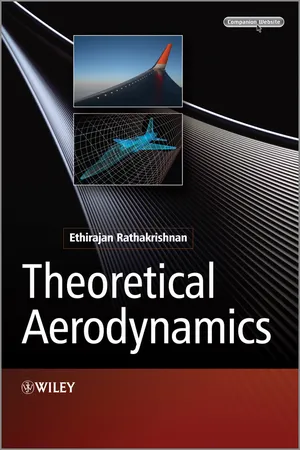![]()
1
Basics
1.1 Introduction
Aerodynamics is the science concerned with the motion of air and bodies moving through air. In other words, aerodynamics is a branch of dynamics concerned with the study of motion of air, particularly when it interacts with a moving object. The forces acting on bodies moving through the air are termed
aerodynamic forces. Air is a fluid, and in accordance with Archimedes principle, an aircraft will be buoyed up by a force equal to the weight of air displaced by it. The buoyancy force
Fb will act vertically upwards. The weight
W of the aircraft is a force which acts vertically downwards; thus the magnitude of the net force acting on an aircraft, even when it is not moving, is
. The force
will act irrespective of whether the aircraft is at rest or in motion.
Now, let us consider an aircraft flying with constant speed V through still air, as shown in Figure 1.1, that is, any motion of air is solely due to the motion of the aircraft. Let this motion of the aircraft is maintained by a tractive force T exerted by the engines.
Newton's first law of motion asserts that the resultant force acting on the aircraft must be zero, when it is at a steady flight (unaccelerated motion). Therefore, there must be an additional force F ad, say, such that the vectorial sum of the forces acting on the aircraft is:
Force F ad is called the aerodynamic force exerted on the aircraft. In this definition of aerodynamic force, the aircraft is considered to be moving with constant velocity V in stagnant air. Instead, we may imagine that the aircraft is at rest with the air streaming past it. In this case, the air velocity over the aircraft will be −V. It is important to note that the aerodynamic force is theoretically the same in both cases; therefore we may adopt whichever point of view is convenient for us. In the measurement of forces on an aircraft using wind tunnels, this principle is adopted, that is, the aircraft model is fixed in the wind tunnel test-section and the air is made to flow over the model. In our discussions we shall always refer to the direction of V as the direction of aircraft motion, and the direction of −V as the direction of airstream or relative wind.
1.2 Lift and Drag
The aerodynamic force F ad can be resolved into two component forces, one at right angles to V and the other opposite to V, as shown in Figure 1.1. The force component normal to V is called lift L and the component opposite to V is called drag D. If θ is the angle between L and F ad, we have:
The angle θ is called the glide angle. For keeping the drag at low value, the gliding angle has to be small. An aircraft with a small gliding angle is said to be streamlined.
At this stage, it is essential to realize that the lift and drag are related to vertical and horizontal directions. To fix this idea, the lift and drag are formally defined as follows:
“Lift is the component of the aerodynamic force perpendicular to the direction of motion.”
“Drag is the component of the aerodynamic force opposite to the direction of motion.”
Note: It is important to understand the physical meaning of the statement, “an aircraft with a small gliding angle θ is said to be streamlined.” This explicitly implies that when θ is large the aircraft can not be regarded as a streamlined body. This may make us wonder about the nature of the aircraft geometry, whether it is streamlined or bluff. In our basic courses, we learned that all high-speed vehicles are streamlined bodies. According to this concept, an aircraft should be a streamlined body. But at large θ it can not be declared as a streamlined body. What is the genesis for this drastic conflict? These doubts will be cleared if we get the correct meaning of the bluff and streamlined geometries. In fluid dynamics, we learn that:
“a streamlined body is that for which the skin friction drag accounts for the major portion of the total drag, and the wake drag is very small.”
“A bluff body is that for which the wake drag accounts for the major portion of the total drag, and the skin friction drag is insignificant.”
Therefore, the basis for declaring a body as streamlined or bluff is the relative magnitudes of skin friction and wake drag components and not just the geometry of the body shape alone. Indeed, sometimes the shape of the body can be misleading ...





